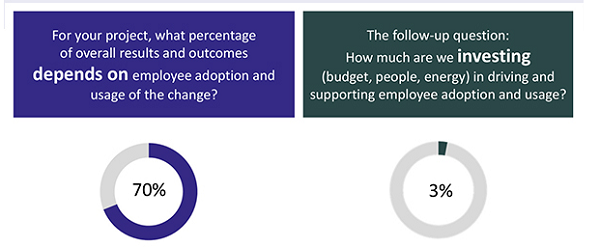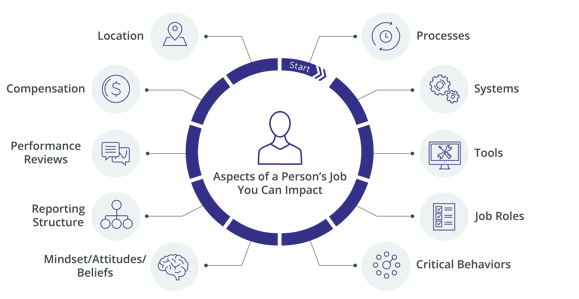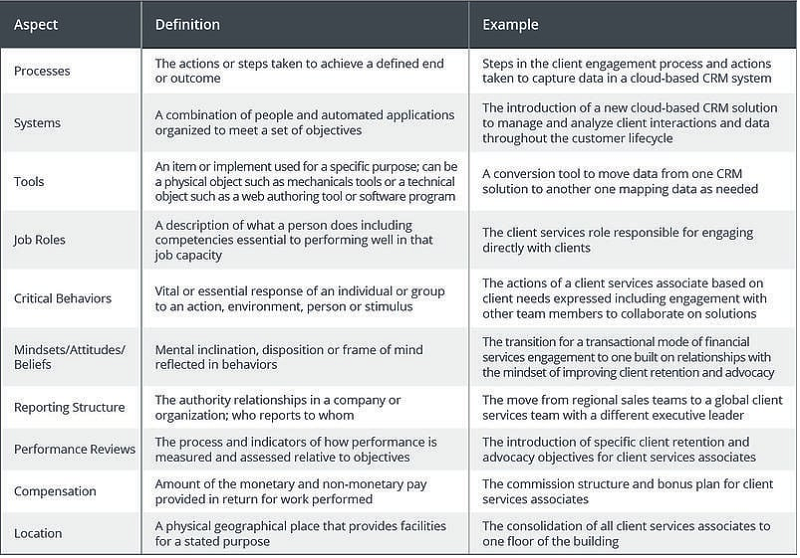(Successful Change Management -11 Elements Cont. 2)
5. Share common language of change (change initiatives can cause confusion and ambiguity; this can be handled by introducing a common language with respect to change; this opens opportunities for more effective conversations, dialogue, feedback, etc that can result in improved project results, increased visibility of change, improved communications and engagement, treatment of change as a process, greater acceptability of the change, easier to identification and addressing of barriers to change, etc
At all organisational levels, the common language has to be:
- easy to explain
- easy to understand
- aligned with people's natural experience
- based on common sense
- providing common understanding and dialogue
- articulating the change process
"...a common language to change that utilises words that everyone in the organisation can relate to allows change to become something everyone can not only understand but positively influence..."
Kent Ganvik, 2023)
6. Develop your own change framework and implementation techniques (for frameworks and for techniques, there is 'not-one-size-fits all or most'; generally building a hybrid that is most suitable for your current situation is the best approach; use evidence-based analysis.
"...what is needed is a framework that enables change practitioners to remind, focus, dissect and document the......journey..."
Prosci, 2023e
Remember: what worked in the past, is not guaranteed to be successful now or in the future.
NB In this Knowledge Base, there are 150+ frameworks and 320+ change implementation techniques that you can choose from; be prepared to 'cut and paste' and change content to get the framework and/or techniques that are most suitable for your situation.)
7. Allocate appropriate resources to change (need to have adequate resources (money, time, expertise, etc) allocated to change initiative(s); successful initiatives will integrate the art and science of change management.)
8. Focus on the people side of change from the start (understand how the change will impact at individual levels.
Generally, there is too much focus on the organisational (eg technical, rational, analytical, logical, tangible, etc) side of change and not enough on the individual (such as human, people, emotional, intangible, etc) side of change. Yet it has been repeatedly found the people-side has a greater impact on successful change than the technical side, despite receiving less investment. Also, inappropriate resourcing and prioritising risks of losing people along the change journey and increases the chance of resistance to the change.

(source: Andrew Horlick, 2023a)

(source: Prosci, 2023b)
The table below identifies the impact on individuals of the 10 aspects of change, ie what the change means to them:

(source: Tim Creasey, 2023)
The above table is like a checklist; it can uncover change impacts that would otherwise be missed. In fact
"...facilitating this activity with a project team, using a design-thinking, interactive approach with a ton of sticky notes at a conference room wall can be cathartic and engaging pursuit..."
Prosci, 2023e
The framework can be used in other ways:
- to build empathy (develop a better understanding of how the change will impact on themselves and others; empathy helps by encouraging people to be more responsive and reflective, and as a result develop better solutions, etc that are aligned with the people it will impact;
"...putting yourself in another's position to understand what they see, feel and experience unlocks insights......to consider how an employee shows up every day and the impact the initiative will have on that person's experience at work..."
Prosci, 2023e)
- define ability (it is defined as a
"...demonstrated capability to implement 'the change' and the achievement of 'the desired change' in performance or behaviour......so that employees can be prepared, equipped and supported to make those specific changes..."
Prosci, 2023e
- create adoption metrics (need to define adoption and usage, ie sufficiently adopted and proficiently used; use adoption and usage to answer the question 'what will we measure to determine if the change is happening?'
- engage employees (encouraging co-creating and/or co-designing to develop a shared definition and understanding of the change process and its impact will increase staff engagement, empowerment, etc while increasing their understanding of the change)
- identify blind spots (it is hard to understand how a large enterprise transformation will impact individuals; the framework can help)
- personalise engagement (with digitalisation, each individual can receive a unique and customised experience in a digital space. For example, a Facebook feed is uniquely yours.
Practitioners
"...can more effectively personalise their support and intervention..."
Prosci, 2023e)
- leverage stories and personas (use narratives to formalise empathy by humanising the needs of particular stakeholders; narratives
"...add value because of the perspective they encourage - outside-instead of inside-out......'outside-in' perspective on change initiative inside the organisation by placing the focus on how employees day-to-day jobs will change..."
Prosci, 2023e)
- scale intervention (need to answer the question
"...How much change management do we need?..."
Prosci, 2023e)
Furthermore,
"...we know that the achievements of the organisation are the results of a combined effort of individuals that make up an organisation. So, if you focus only at the enterprise level when you implement change, you risk losing people along the way......if we can't get people to the future state and help them stay there, they can regress back to the way they used to do things. We end up with a compromised future state......we don't realise the expected value. Furthermore, we create consternation and resistance..."
Prosci, 2023e
Bring change impact into focus so people have a clearer picture of what is happening and where they are heading.
NB Each person is unique and will react differently to change. However, there can be some degree of predictability in people's reaction. For example, if you are successfully encouraging participation so that employees to buy-in (ownership) of the change process. This can be done by co-creating/co-designing how to handle change, developing the process, etc. Then it becomes their change process and not just a dictate from senior management and/or consultants, etc. Based on successful buy-in, employees will participate actively and greatly increase the chance of success.
On the other hand, keeping people in the 'dark' and dictating the change process to them will result in a lack ownership of the change process and resistance will increase.
NB In all change
"...people are the common denominator in achieving intended outcomes..."
Prosci, 2023n )
